Sporting
For the Love of Quail
When the Rollins family isn’t overseeing a vast business empire and philanthropic foundations, you’ll find them among the Old Florida live oaks and cabbage palms of Blue Cypress Ranch, where the bobwhite is king—and a kennel of American-bred British Labrador retrievers is turning heads in the dog world

Photo: Peter Frank Edwards
Head trainer Jeremy Criscoe with Finn, one of Blue Cypress Kennels’ British Labs; Pointers lead the way on a quail hunt at the Rollins family’s Blue Cypress Ranch.
When R. Randall Rollins was a child, perhaps four or five years old, he would follow his father on their North Georgia farm, hunting quail in the rolling mountains of Catoosa County just shy of the Tennessee state line. The family had eighty acres of land and a house built from timber they’d cut themselves. They grew cotton, corn, and sweet potatoes, and raised chickens, hogs, and cows. “My dad loved the land and all the things it could provide,” Rollins recalls, his voice trailing back to a time eight decades distant. “And he just loved everything about hunting.”
This was before his dad, O. Wayne Rollins, traded full-time farming for work at the Standard-Coosa-Thatcher textile mill in nearby Rossville, Georgia, and before his father and uncle John W. Rollins bought a radio station in Radford, Virginia, that kicked off a regional broadcasting dynasty, and before they borrowed $60 million in 1964 to buy Orkin pest control in the first leveraged buyout recorded in the United States. In the years to come, the Rollins family would crack the top 50 on the Forbes list of wealthiest American families and oversee a philanthropic outreach via the O. Wayne Rollins Foundation and other family foundations that would give hundreds of millions of dollars to colleges and universities across the South and beyond—including a recent gift of $65 million to Atlanta’s Emory University for the third Rollins School of Public Health building, slated to break ground next year.
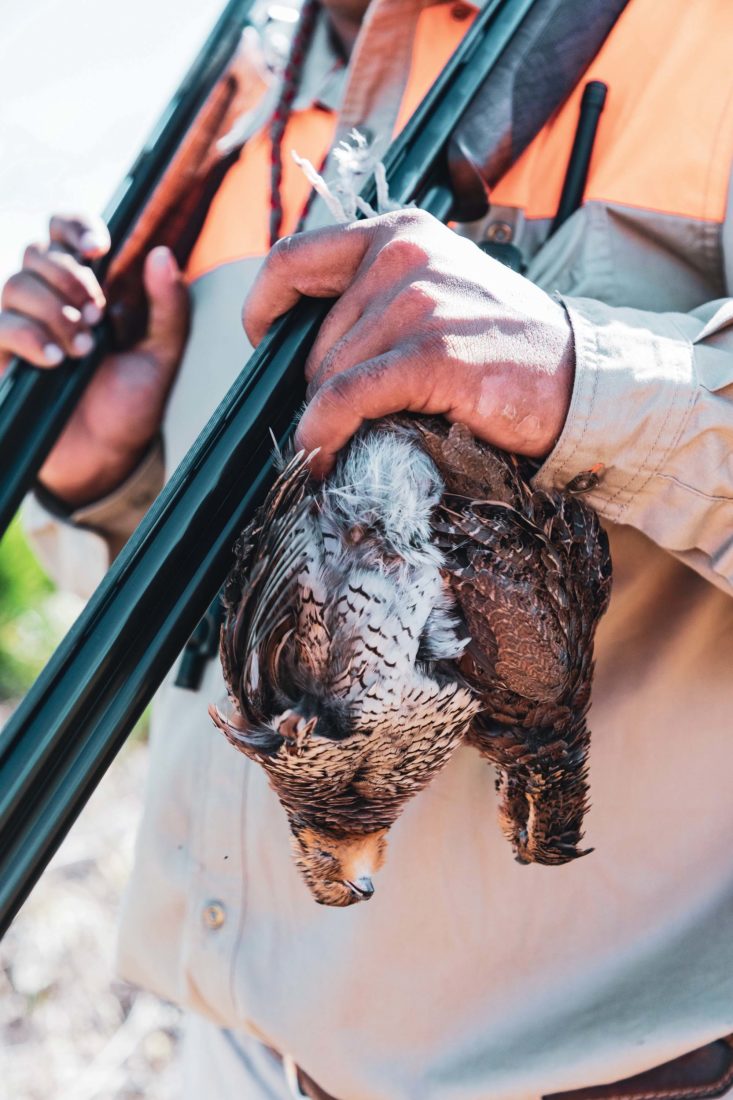
Photo: Peter Frank Edwards
A brace of quail.
To that little boy in the Georgia hills in the late 1930s, however, his dad was simply a farmer in overalls. “The kind with that little hammer loop on the side,” Rollins remembers, “and he would have me hold on to that loop when we walked up to the dog on point, so he would know exactly where I was when the covey got up.”
This image—the little boy holding on to his father, the two of them making their way across the North Georgia fields, each of them with a heart pounding for the wild harvest of their land—is a useful way of understanding the passions of this fabled Southern family. Today the Rollins family of Atlanta, led by Randall, who is eighty-seven, and his seventy-five-year-old brother, Gary W. Rollins, oversees a holding company that includes large oil and gas businesses, the boat enterprise that builds Chaparral and Robalo craft, and a pest-control empire with nearly twenty subsidiaries. But land stewardship remains a critical expression of the family’s history. On landscapes far larger than those of their youth, Randall, Gary, and their extended families pour heart and soul and treasure into a broad portfolio of cattle, farming, and sporting properties, with sprawling ranches in Texas and Georgia, and four significant properties in Florida.

Photo: Peter Frank Edwards
Callum Macgregor, Tim and Andrea Rollins, Gary and Kathleen Rollins, and Jeremy Criscoe; Gemma, a young British Lab in training.
And it’s to the Old Florida country west of Vero Beach where they retreat to chase birds across the seven-thousand-acre Yeehaw Plantation, part of a larger forty-thousand-acre cattle spread called Blue Cypress Ranch. At Yeehaw, the two brothers oversee separate compounds of stunning family cottages built under live oaks and cabbage palms, and Randall in particular shepherds a kennel, Blue Cypress Kennels, and a line of American-born British Labrador retrievers that has turned the retriever world a bit on its end, if not upside down.
Land and cattle, land and crops—and land and quail and dogs. It seems the only thing that’s changed is the scale of the boundary lines.
On a February morning, on the winding-down side of bobwhite quail season in Florida, I join the Rollins clan for a long weekend at Yeehaw. It’s hot by 10:00 a.m. as our entourage threads along a vast grid of soaring pines, broom sedge, and tangled ribbons of saw palmetto in the wet bottoms. Three horse-mounted dog handlers follow pointers on the ground, trailed by a massive canvas-roofed quail wagon unlike any hunting conveyance I’ve ever seen.
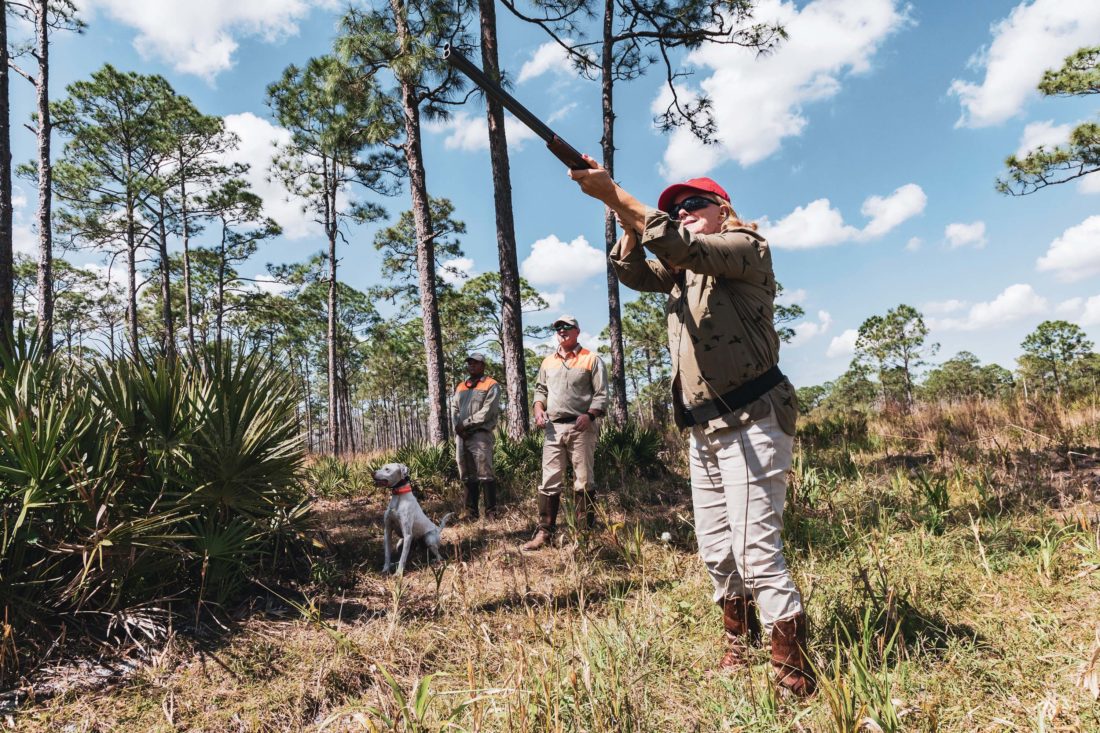
Photo: Peter Frank Edwards
Kathleen on a bird.
“There’s sixty years of evolution up here,” Gary Rollins says with a laugh, referring to the swanky digs of the jacked-up quail wagon, a pet project of his father’s. We’re riding on upholstered seats, within reach of two coolers and dishes filled with pecans, potato chips, peanuts, Bit-O-Honey candy, and shotgun shells. Callum Macgregor pulls open a drawer. He’s the Rollins family chief legal officer and a highly skilled Scottish-born dogman. “There’s a chessboard in here somewhere, if we get bored,” he says. Which is unlikely. At the moment we’re chugging ice water to cool off after the fifth wild covey point in a hunt but ninety minutes old.
The buffet takes over the storied sleeping deck of O. Wayne Rollins, who famously napped on the wagon. “Dad was from a generation that came in from the fields, had a big lunch, and took a nap at the house,” Gary explains. “And he’d nap right in the middle of the hunt, while we kids would find us some shade and play mumblety-peg for an hour or two.”
The view is as vast as an African plain, but suddenly the dog handlers mark the point with raised caps and horses reined in tight and still, and all focus narrows down to that wedge-shaped world in front of the dog’s nose. Gary and his wife, Kathleen, are on point to shoot, and I climb out of the wagon to fall behind head trainer Jeremy Criscoe for the dance.
It’s a treat to see these husband-and-wife hunting pairs. Watching from the quail wagon are Randall’s son Tim, vice president of the family’s holding company, and his wife, Andrea, a physical therapist and mom to their four boys. Randall’s wife, Peggy, is an avid hunter as well, and such a natural shot, he tells me later, laughing, “that it’s kind of aggravating, to be honest.”

Photo: Peter Frank Edwards
Macgregor sends Gus on a retrieve.
Gary and Kathleen split around a soaring copse of saw palmetto, greenbrier, and god-awful thicket. While the Rollins family has taken great pains to turn this slice of Florida cattle country into a classic Southern quail plantation—selectively thinning trees to let sunlight spill to the ground, burning the pines with prescribed fire on a two-year rotation, bushhogging and mowing a grid of shooting paths—the wild birds know where to run for cover. The two shooters settle into position as Criscoe releases the pointers for the flush, but they have their work cut out for them as well. The dogs vanish into the brush, and I can hear their heavy breathing and the birds skittering as an entirely unseen chase takes place. When part of the covey flushes, wings rattling across the palmetto spikes, doubling the rushing sound of the rise, Kathleen immediately drops a single. But there are more birds in the thicket—Criscoe figures it might be two coveys hemmed in together. There’s more work to be done.
Through it all, Gus, one of Randall Rollins’s prized British Labrador retrievers, holds tight at Criscoe’s square-tipped snake boots, like a coiled spring. Criscoe remains calm, radiating his demeanor toward the dog at his feet. He’s honed his approach to training over decades. A former U.S. Navy rescue swimmer, he worked for the famed Wildrose Kennels of Oxford, Mississippi, ran his own Whistling Wings Kennel out of Alabama, and designed a puppy socialization protocol with Auburn University’s Canine Performance Sciences program.
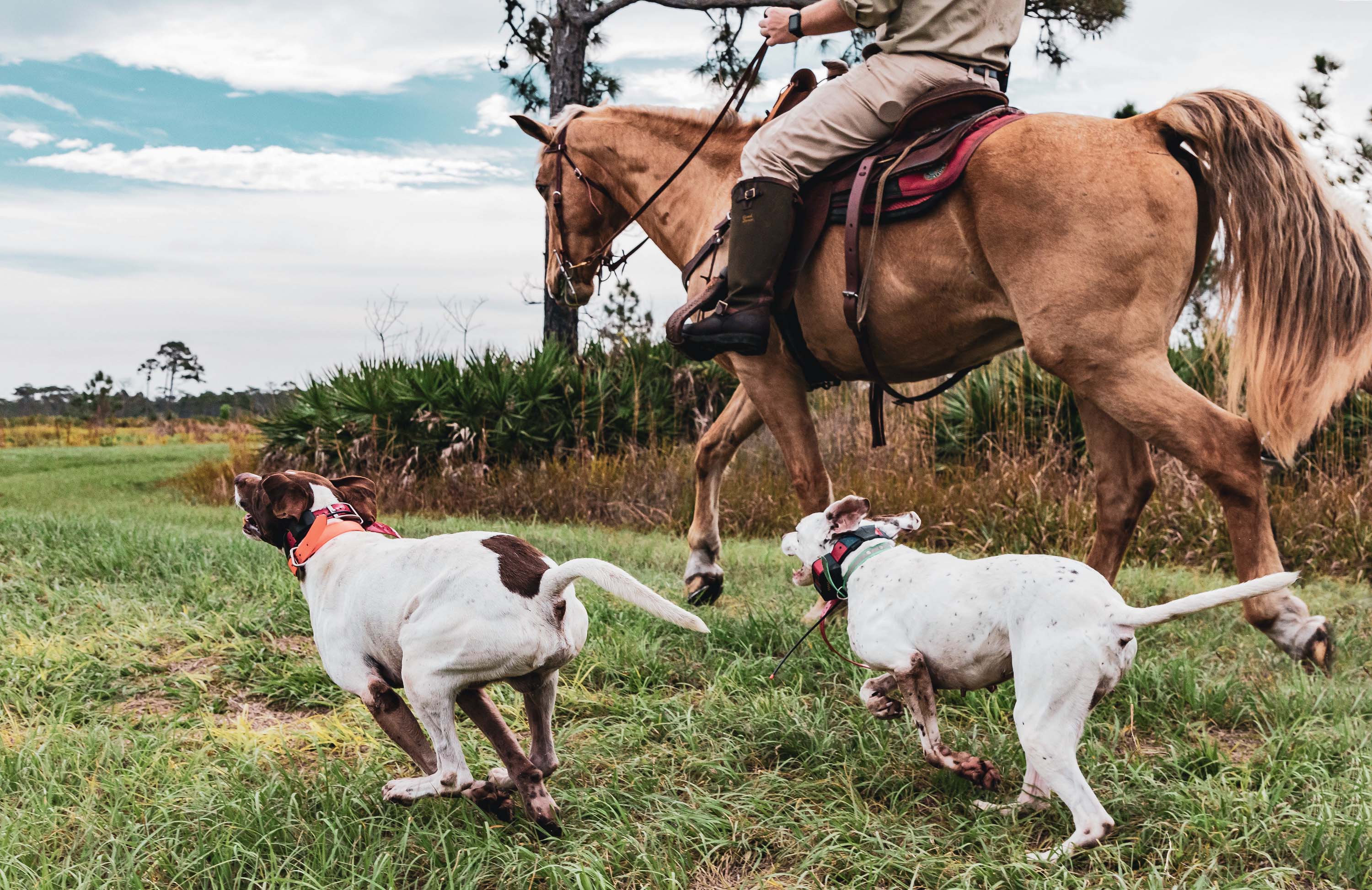
Photo: Peter Frank Edwards
Pointers on the move.
Now the birds blow out in singles and threes and fours, and then a full covey explodes, arcing overhead to bomb into a tangled swamp bordering the course. It’s too thick to shoot through the brush, the birds too fast to track, the covey too determined to make it to a swamp for safety. Tim calls out from the quail wagon: “All y’all have to do now is swim across that water hole and you’ll be right on them!”
It’s quite a scene: two pointers in the field, two hunters, huntsmen on horseback, and the wagon with hunters standing by. The Labrador is called in to work only after the pointers have the covey pinned down and the hunters have fired. There are a lot of moving parts to confound a dog and break concentration. “A large-party hunt like this is the big leagues,” Criscoe says. “It’s a pretty serious deal for a dog.”
Gus, in particular, has proved that he has what it takes.
That retriever, Augustus Fink-Nottle, named for a character in the novels of P. G. Wodehouse, has broken new ground: Trained by Macgregor, Gus is the first American-bred, -born, and -trained British Lab to travel to the United Kingdom and win some of its biggest field trials. And he did it when he was only twenty months old. Running in the 2017 campaign season, with two British handlers, Gus scooped up numerous second- and third-place finishes before capping it off with first place at the prestigious Gamekeepers National Association Field Trial in Scotland and two top awards from the Northern Ireland Gundog Club and Field Trial Society.
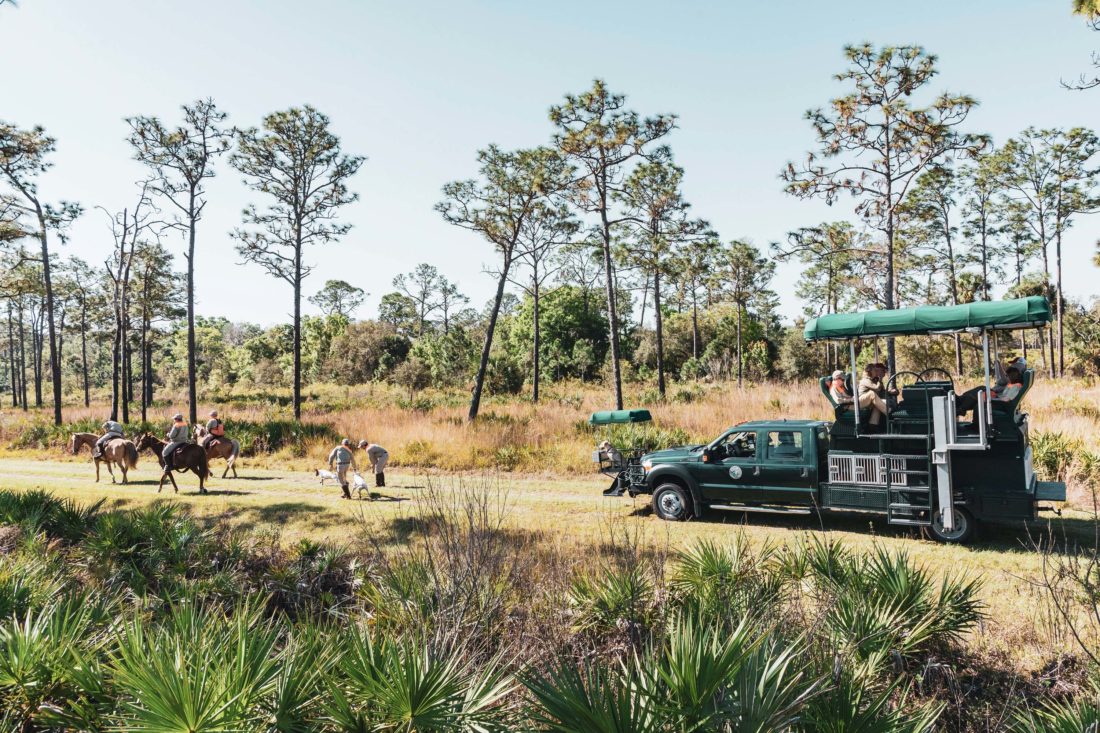
Photo: Peter Frank Edwards
The hunting party.
The magnitude of the feats goes beyond just the firsts for an American dog behind U.K. lines. “To take a dog that has been trained on a Florida quail plantation with horses and palmettos and hot weather, and put him on a plane to run in field trials through Scottish heather and gorse and wet gray mist to find a kind of bird—a grouse—that he’s never really seen before, that was quite remarkable,” Macgregor says. “And oh, yeah, you’re going to be handled by a woman speaking with an accent you’ve never heard. Good luck. A lot of dogs have great genetics and great training. What separated Gus is his temperament. You could see it in his eyes. He was like, Yeah, it’s all good. I can handle this.”
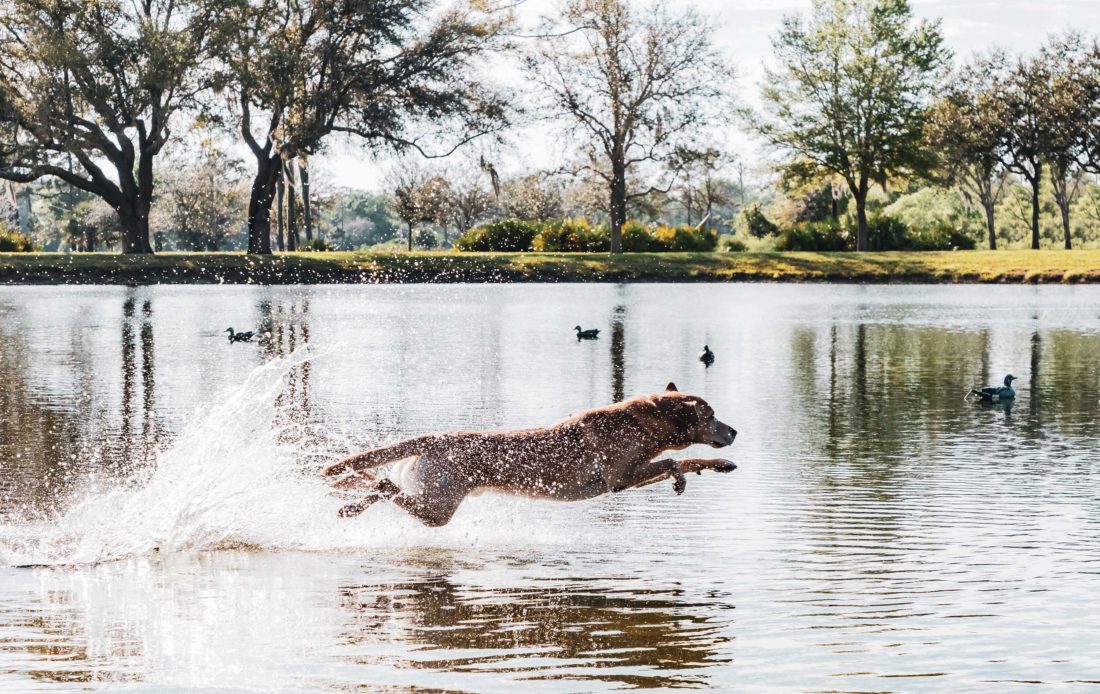
Photo: Peter Frank Edwards
Gus, one of the kennel’s prized British Labs, at work.
One afternoon, at a training pond behind the 20,000-square-foot Blue Cypress Kennels, Macgregor, Criscoe, and assistant trainer Noah Stapler lead to the water a six-pack of retrievers: Gus, Ben, Finn, Murphy, Tina, and Biscuit. All of the kennel’s puppies are born, raised, and trained in the United States and are no more than one generation removed from champion sires and dams born and campaigned in the United Kingdom. Perhaps a dozen litters are born each year at the Orvis-Endorsed kennel, with prospective buyers carefully matched to specific litters.
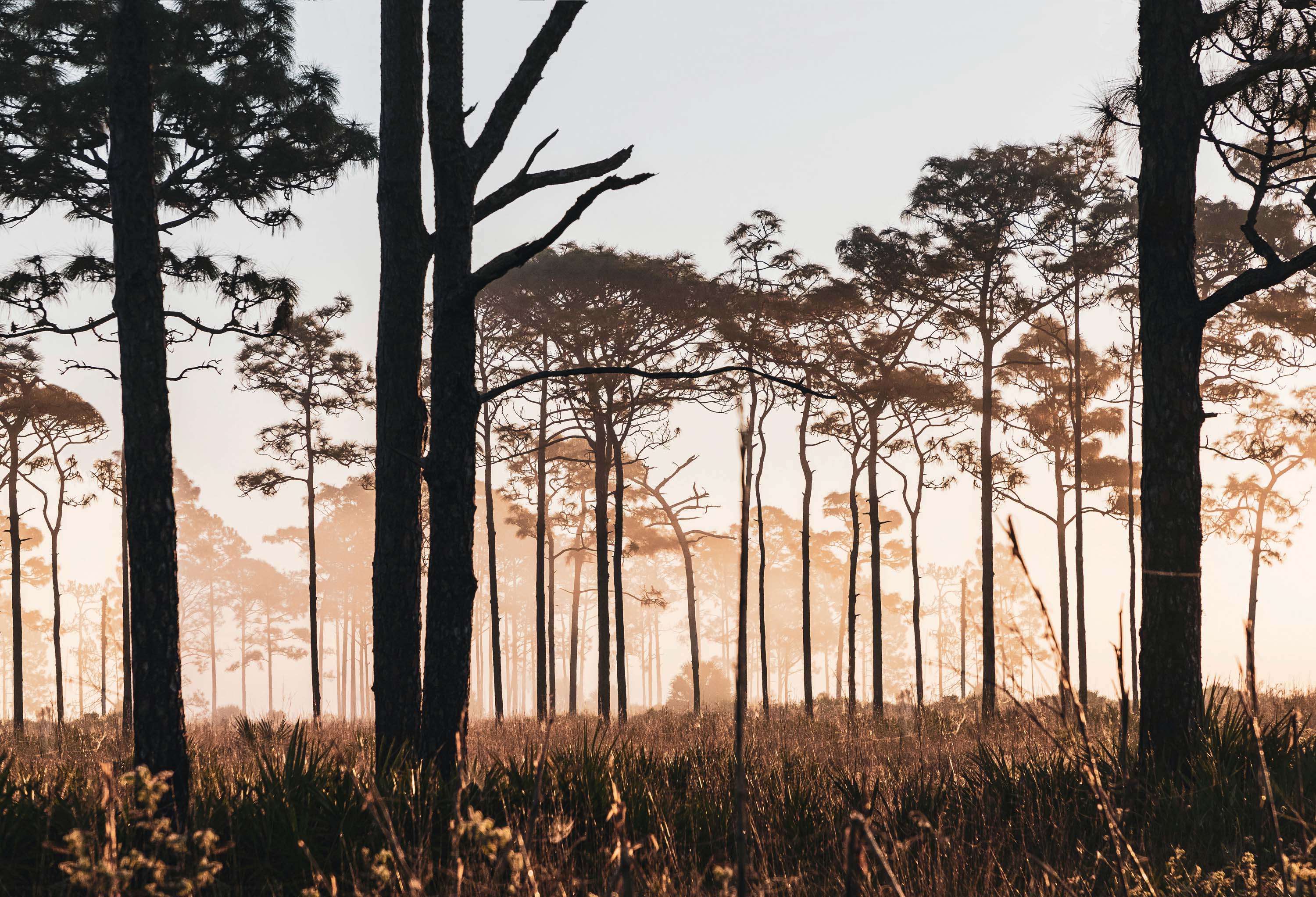
Photo: Peter Frank Edwards
Early morning among the pines.
At Blue Cypress, trainers highlight both drive and sociability, exposing puppies to everything from rides in the plantation vehicles to piped-in music. “We think about those times when your buddy brings his dog to a hunt, and you all have to share a blind,” Criscoe explains. “Or you’re relaxing after a hunt at the lodge and the dogs are milling about. Many dogs spend far more time with the family than on the hunt. It’s not just about being the fastest dog to the bird.”
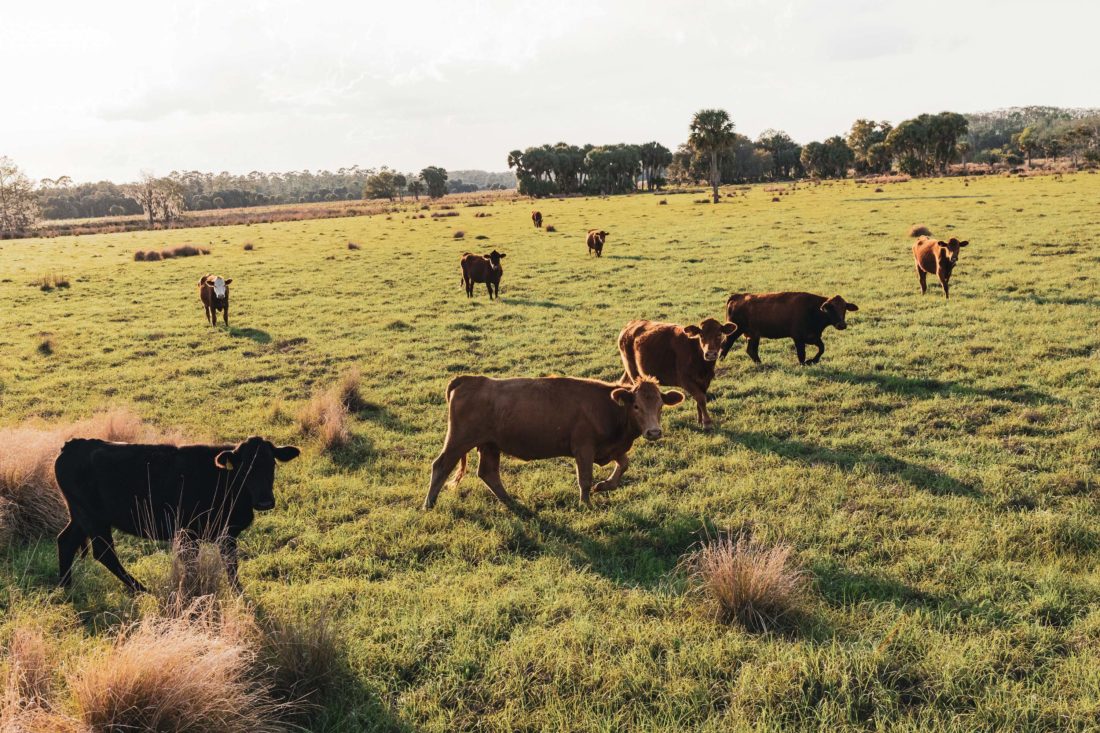
Photo: Peter Frank Edwards
Cattle grazing at Blue Cypress Ranch.
That approach helps explain what is a bit of an Atlantic divide in the Labrador retriever field-trial world. Though none of the national registry organizations or clubs, such as the American Kennel Club, recognize a breed difference between American and British Labs, variations in body style and temperament have evolved. Typically, American Labs are taller and slimmer, with a narrower head and neck. Their fans consider them to have more athleticism and energy than British Labs, which are stockier and blockier and viewed as somewhat calmer and more mellow. American sporting dog competitions tend to emphasize a dog’s specific skill sets, such as an ability to take an unfailingly straight line and retrieve across distances that can measure in the hundreds of yards. U.K. field trials are almost always held with live birds, in situations that mimic an actual hunt. “In the U.K. campaigns,” explains Macgregor, “when you shoot a pheasant and it goes into the woods, you send your dog after it and put your hands in your pockets and pray like hell that the dog brings the bird out. The dog is expected to figure it out on his own, and a failure to retrieve boots you out of the trial.” British Labs are typically superior game finders, their natural ability honed by positive reinforcement. The use of e-collars when training British Labs for campaigning is nearly unheard-of; in fact, some U.K. countries ban the collars altogether.
A common refrain about British Labs is that they’re “hell in the field and calm at your feet.” Part of that, Macgregor says, derives from the temperament required to participate in the large driven British estate shoots, which can involve hundreds of birds and sometimes more than a dozen hunters. Even today, a dog that barks, or yelps, or even squeaks or shifts its feet during a British trial is immediately disqualified.
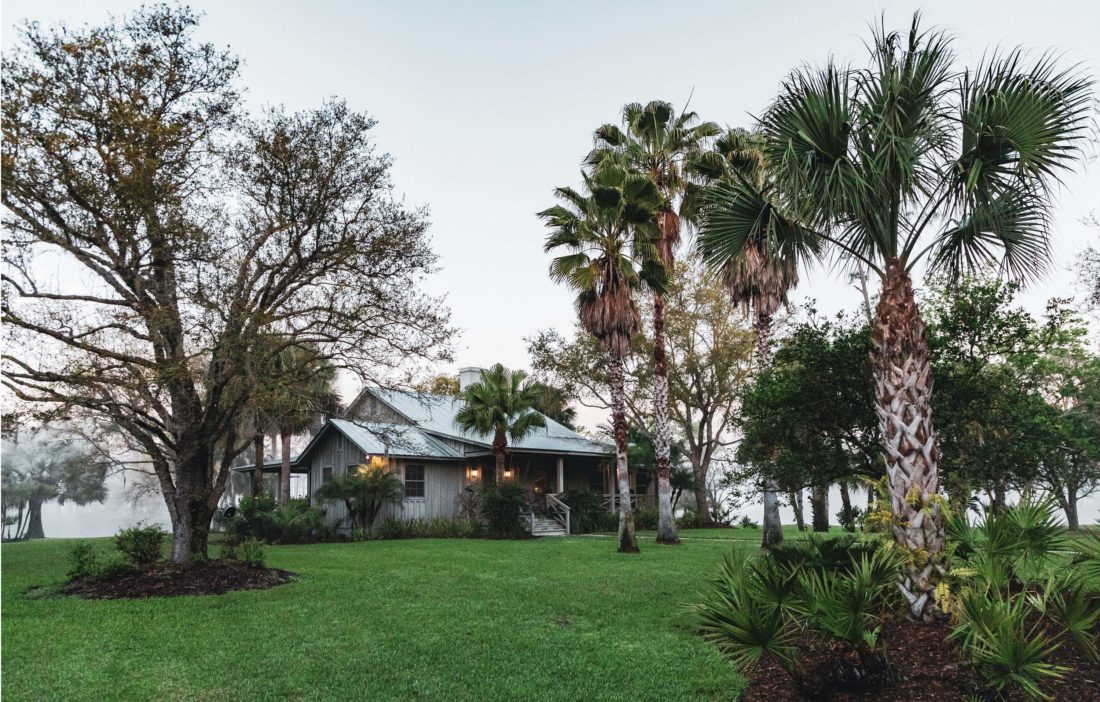
Photo: Peter Frank Edwards
The family dining hall
These generalizations don’t apply to every dog in every situation, certainly, but they do offer some insight into what potential retriever owners consider when making a choice. “I’ve never felt that one is necessarily better than the other,” says a purposefully circumspect Criscoe. He compares the two breeds to a Corvette and a Jaguar. “Some people like going like hell as fast as they can in a straight line,” he says, laughing. “And some people like a smoother, more luxurious ride. They’re both impressive. It’s just that the British dogs are better for me.”
The Rollinses didn’t always have championship dogs. “Growing up, we’d buy a good dog,” Gary recalls, “so we’d have a good dog that first year. Then he’d be about half a dog that second year, and by the third year, he would be no dog at all.”
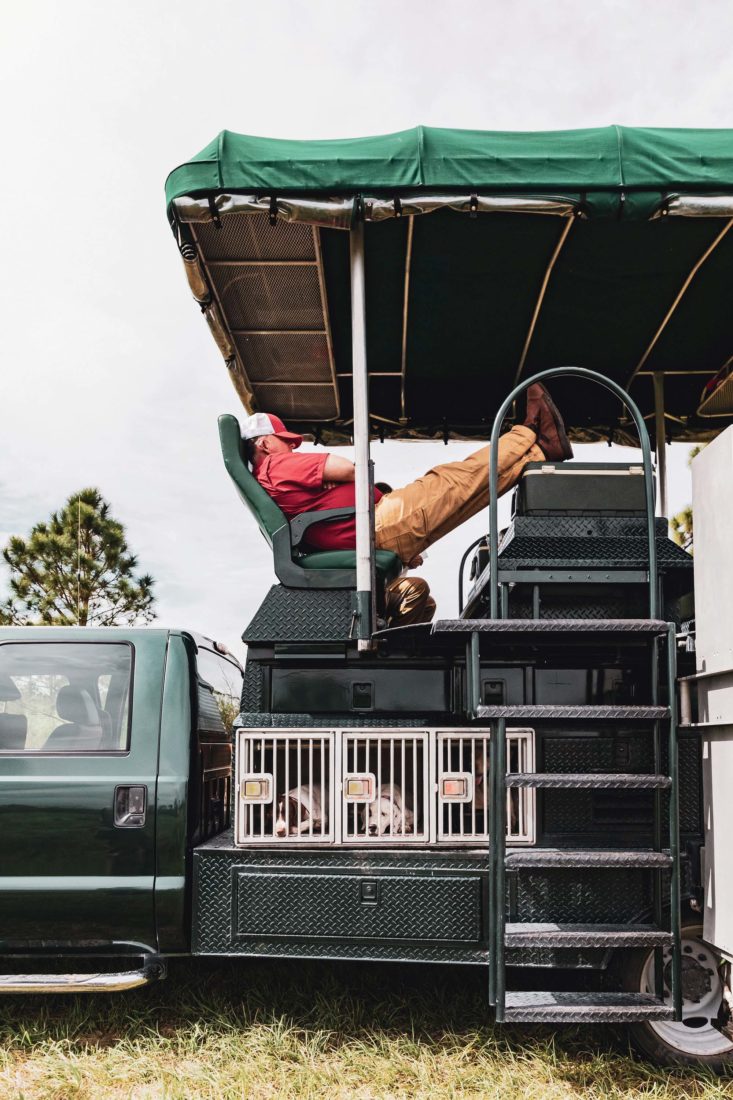
Photo: Peter Frank Edwards
Tim Rollins catches a quick nap on the wagon.
Today Gus’s acclaim, the exquisite training facilities—none of this comes as a great surprise to those who know the Rollins family, and certainly not to those who have seen Randall Rollins at work, whether building businesses or breeding cattle. “Randall’s approach to everything is to work to make it better,” Macgregor says. “It makes no difference what it is. When his kids started to ride horses, he wanted to spend time with his kids, so he bought horses. And like everything else, Randall’s approach was: Well, how good can we be?” Quite good, as it turned out. Rollins eventually owned Ace’s Sensation, who in 1970 won Grand Champion Walking Horse of the World.
Randall brushes it off with a breezy, avuncular charm.
“My wife says I can’t do anything for fun, because I’ll turn it into a business,” he says. “And there’s some truth in that. I throw myself into the things that interest me. I want to make them better. That was instilled in me by my parents and grandparents—an obligation to leave things better than when you found them.”

Photo: Peter Frank Edwards
Macgregor gives Ben some love.
In fact, what happens at the kennels and the training grounds and beside the quail wagon is less the main course than a distillation of the Rollins family’s life and business and avocation. The boundaries, they will admit, can sometimes be difficult to tease apart. The brothers still pull five- and six-day workweeks, overseeing the family empire, interspersing days spent on corporate boards with ranch management meetings, philanthropic endeavors, and the constant tug to get back to the woods.
Early one evening in his tin-roofed Florida Cracker–style cottage in the family compound, after a full day of hunting and exploring the property’s back roads and big swamps, Gary Rollins settles into a porch rocker, dressed in short chinos and a blue shirt that matches his eyes, as we work through appetizers of crabmeat, hush puppies, and deep-fried pimento cheese. Over bourbon in clinking glasses, he tells rollicking stories about some of the old ranch cowboys—men with names like Peanut and Spooky Guy—big gators in the swamps, wrecked boats, the old Seminole camps found deep in these woods. We chuckle about the tough hunting earlier—the birds that beat us, the dogs working hard in the heat.
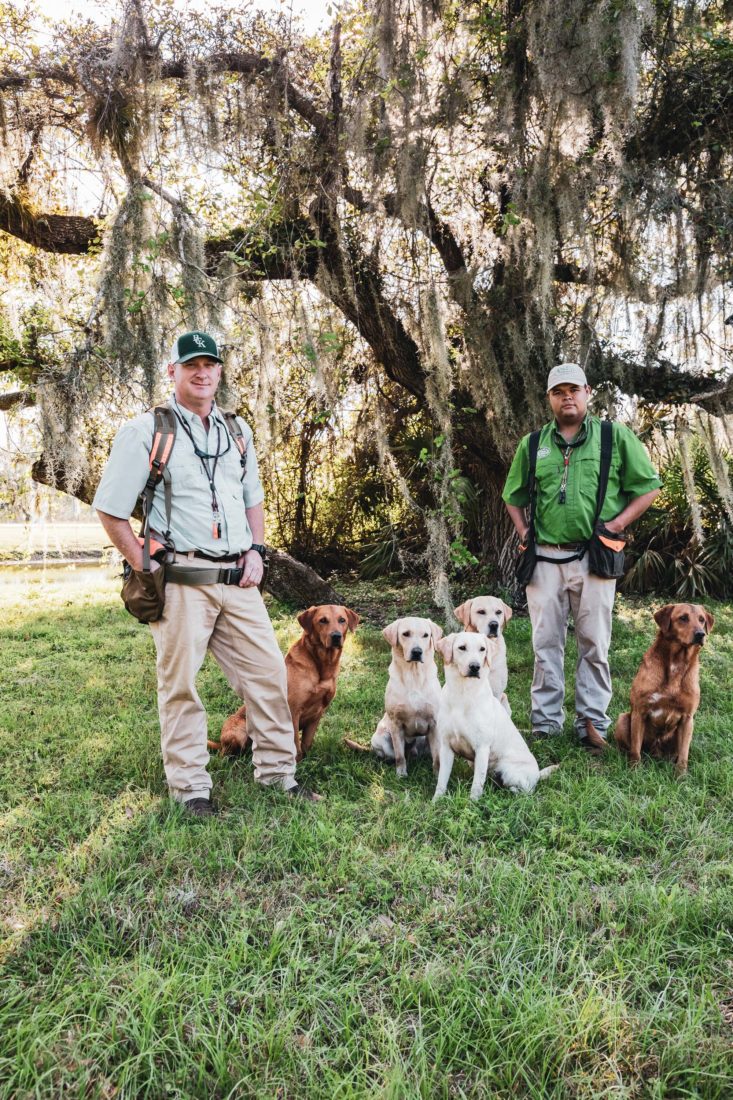
Photo: Peter Frank Edwards
Criscoe (left) and assistant trainer Noah Stapler with a number of the kennel’s Labs.
“Daddy was a cowman, and I think that’s why he had no interest in big-game hunting,” he says. “But the quail deal was different. On Christmas week we’d hunt every day unless it was raining so hard you couldn’t stand up. That meant we’d buy all our Christmas presents at the store on Christmas Eve when everything was so damn picked over there was hardly anything left, but the whole family was pretty good about it. The land here is the glue that holds this family together. The pleasure we find here is significant. But what we do with the land is important and enduring.”

Photo: Peter Frank Edwards
An engraved Beretta.
After drinks I follow Gary and Kathleen to dinner as they walk hand in hand toward the family dining hall, under cabbage palms lit with fairy lights, the walkways ablaze with torches. And though the scene is underscored with the trappings of family dynasty, the seeds of the Rollins family’s pursuits here were sown in decidedly leaner times.
Randall Rollins remembers another story from his childhood, when a huge snowstorm dumped eighteen inches on northern Georgia. “That was a record for our part of the country,” he recalls. His father had his town job at the textile mill by then, but he still farmed long and hard on nights and weekends.
When the snowfall stopped, O. Wayne Rollins took his son out with shovels and brooms. “We knew where there were about six bird coveys on the farm,” Randall says, “and we spent the next day digging down into the snow and sweeping bare spots out so we could put scratch feed out for the quail. I never will forget that. My father just wasn’t going to let those birds freeze on his farm. They were in his care. For my brother and me, those kinds of attitudes are just ingrained.”







